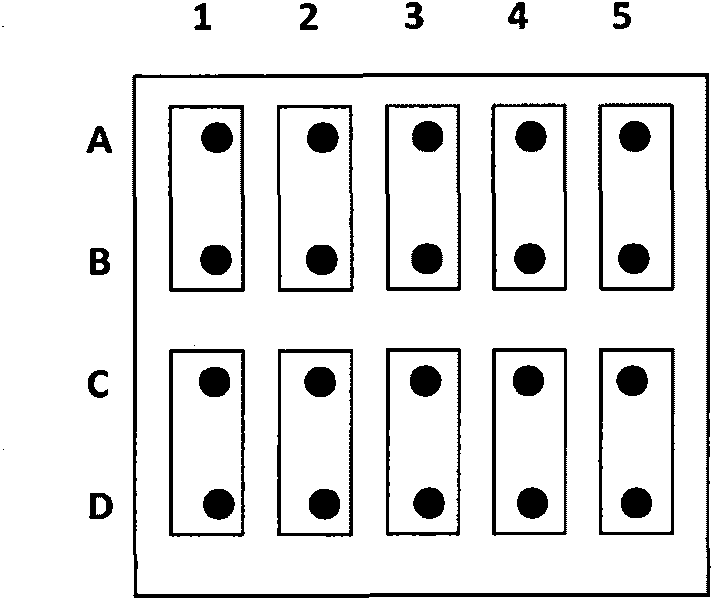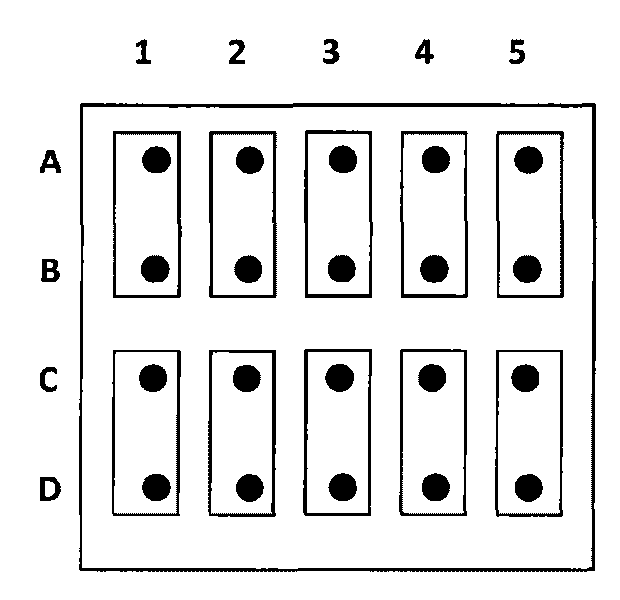Biological chip for synchronously detecting typhoid and paratyphoid and preparation method thereof
A biochip, paratyphoid technology, applied in measurement devices, resistance to vector-borne diseases, instruments, etc., can solve the problems of time-consuming and labor-intensive detection efficiency, and can not be detected at the same time, and achieve the effect of saving time.
- Summary
- Abstract
- Description
- Claims
- Application Information
AI Technical Summary
Problems solved by technology
Method used
Image
Examples
Embodiment 1
[0035] Preparation of Biochip for Simultaneous Detection of Typhoid and Paratyphoid
[0036] Such as figure 1 As shown, a biochip for simultaneously detecting typhoid fever and paratyphoid fever includes a poly-L-lysine-activated glass three-dimensional chip substrate, and the substrate is provided with at least one detection unit, and the detection unit is provided with a detection unit. The dot matrix of samples to be inspected is a 4×5 double-site design; from top to bottom, A, B, C, and D represent rows respectively, and from left to right use numbers 1, 2, 3, 4, 5 represent columns, respectively. Among them, each site A1, B1, C1, and D1 represents the quality control point; each site: A2, B2 represents the typhoid O site; A3, B3 represents the typhoid H site; A4, B4 represents the typhoid VI site; A5, B5 C2 and D2 represent paratyphoid B loci; C3 and D3 represent paratyphoid C loci; C4 and D4 represent negative control (NC) loci; C5 and D5 are blank control loci. The a...
Embodiment 2
[0044] Assembly of the assay kit
[0045] 1. The biochip 2TX10 / 20 described in embodiment 1
[0046] 2. 1 bottle of specimen diluent (2.5 / 5ml, blue)
[0047] 3. 1 bottle of tracer (2.5 / 5ml, red)
[0048] 4. Chromogenic agent 1 bottle
[0049] 5. 2 / 4 bottle of washing liquid (18mlX2 / 4, used directly)
[0050] 6. Instruction manual 1 piece
[0051] 7. Bring your own wet box: put a layer of wet gauze in the lunch box.
Embodiment 3
[0053] Simultaneous detection of Salmonella typhi infection by detection kit
[0054] The kit described in Example 2 was equilibrated to room temperature. Specimen dilution: Dilute the serum specimen 1:20 (15ul~300ul) with the specimen diluent and mix well in the test tube. Adding samples: Take out the chip and unpack it and place it flat on the test bench, add 200ul of diluted samples to each grid, and make sure that the samples cover the grid. Incubation: Place the chip in a wet box and incubate at 37°C for 30 minutes. Shake off the liquid in the grid, add 4 drops of washing liquid to each grid, shake it off immediately, wash 3 times in a row, and finally wash with distilled water for 1 second, and then dry the water droplets around the grid on absorbent paper. Add tracer: drop 2 drops of tracer per grid, do not overflow the grid. Incubate in a wet box at 37°C for 30 minutes, wash 3 times as above, and blot the surrounding water droplets on absorbent paper. Color develop...
PUM
 Login to View More
Login to View More Abstract
Description
Claims
Application Information
 Login to View More
Login to View More - R&D
- Intellectual Property
- Life Sciences
- Materials
- Tech Scout
- Unparalleled Data Quality
- Higher Quality Content
- 60% Fewer Hallucinations
Browse by: Latest US Patents, China's latest patents, Technical Efficacy Thesaurus, Application Domain, Technology Topic, Popular Technical Reports.
© 2025 PatSnap. All rights reserved.Legal|Privacy policy|Modern Slavery Act Transparency Statement|Sitemap|About US| Contact US: help@patsnap.com


